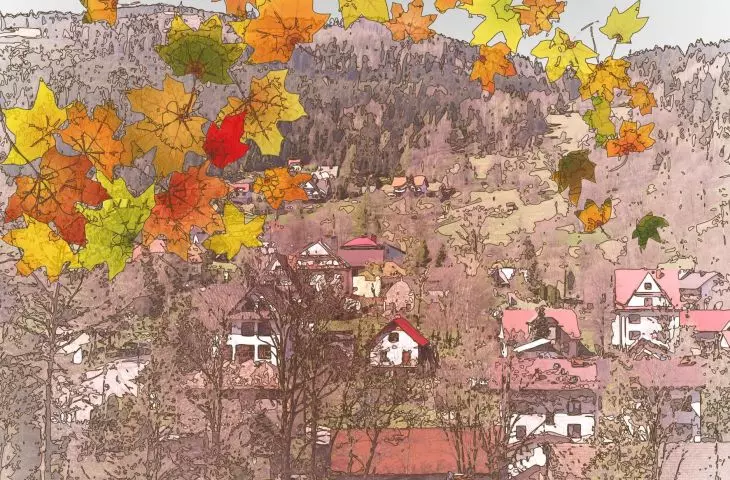Our adopted little homeland
The discussion and initiatives of the Green Deal and the New European Bauhaus, which are beginning in Europe and gaining momentum, are undoubtedly redefining previous goals and directions, opening up new, hitherto unexplored, very broad areas of activity for European societies. Whether these initiatives will have a longer time horizon of functioning and open some new page in European history, or whether they will die a natural death, they cannot be ignored. Most likely, they will take on a diverse character, depending on the peculiarities of a particular country or region. Therefore, the concept of identity, or "inventory" of one's own national and regional conditions, becomes crucial.
I have already happened to write a relatively large number of texts on the identity of the region where I have lived since childhood, my small homeland, Upper Silesia. The multiculturalism of the region, the industrial landscape, and the urbanized space and architecture were always the main theme. However, for more than forty years my wife and I have also had a second small weekend homeland on the very border of the state, in a small Beskid village. It's a wooden cottage, more than a hundred years old, somewhat mangled and repeatedly rebuilt, on the edge of the western range of Babia Góra, opposite the Pilsko massif, a few kilometers from the border pass Glinna, through which the historic copper route ran. With a population of 1,200, it was one of more than 50,000 Polish villages founded in the 16th century by Wallachian settlers arriving from the Balkan Peninsula. It is worth mentioning that the number of cities in Poland is 954, 50 times fewer than villages. Until the communist era, it was a poor Beskydy village, with the population making a living from farming in the difficult mountain lands, sheep breeding and crafts. No relics of history remained in the village, except for a few wooden cottages that gradually disappeared. After World War II until the 1980s, a mass phenomenon of peasant laborers appeared here, commuting to mines up to about 70 kilometers away, significantly changing the previous character of the village, while raising the material status of the residents to some extent. In the 1970s, a large resort and skiing complex was planned to be built here, but the plans fell through, causing less tourist interest in the area. The landscape of the mountain slopes surrounding the village also changed during the transition period. Grain and potato cultivation gradually disappeared, former fields turned into pastures, vast mountain pastures became overgrown with self-sown trees as only two shepherds remained in the village. Instead, dozens of micro-enterprises and family microbusinesses of a very diverse nature have emerged. With a high degree of certainty, this is the history of most Polish villages.



rain
© Piotr Średniawa
Despite being well acquainted with the area and local residents, we did not ponder the identity of this small mountain enclave for a long time, initially noticing only the picturesque mountain landscape. Probably one of the reasons was the common architecture of this village, devoid of any special atmosphere, being a cluttered two-sided street crawling up the surrounding slopes. Wooden houses, have been replaced by relatively large hollow brick buildings with rooms for tourists, a positive change in the eyes of the locals. In recent years, wrought iron fences and gates have appeared, and in the farmyards elements of small leisure architecture such as benches, swings, barbecue areas, which are local and external messages of raising social and material status. Balancing on the edge of this concept, the architecture is typical, not particularly picturesque peculiar Polish aesthetic blandness. It took many years before I realized that the evaluation of this architecture from "urban", depreciating positions is largely unauthorized. This architecture lives a completely different life and rhythm from the urban fabric. This by no means means means some kind of conversion and uncritical acceptance of this space, but an attempt to understand it and the processes taking place in it.
hard to grasp identity
This somewhat mottled architecture of the village, which does not follow the building line, with different angles and roof coverings, certainly has not been and will not be presented in architectural journals and websites. It is completely indifferent whether it was designed by an architect, civil engineer or construction technician. It is realized using BIM, which here means the Undisputed Master Initiative, especially for facades and details. However, this architecture and non-architecture is, what is not obvious at first contact, organically embedded in the surrounding mountain nature. Not through a formal or aesthetic context recognized by our architects, the use of local material or specific detail, but a different kind of relationship, perhaps even truer and deeper. This seemingly bland architecture talks to its inhabitants and nature. You don't have to look out the window, as in the city, to see if it's raining, you can just hear its drops drumming against the roof. In autumn, the architecture whispers with falling leaves rubbing against the roof. In winter, the wooden trusses creak under the snow, and groan as they work hard during the blizzard. In the interiors one can smell the smells forgotten in the city, of flowering trees, cut grass, wilting leaves and smoke from autumn cleanup in the fields. Winter paints icicle ornaments on older windows during the frost, and hangs curtains of icicles on the eaves. Architecture is integrally inscribed in the rhythm of nature. Urban architecture, living outside of nature and the seasons, is devoid of all this. Where in the city the changing seasons are already marked by the changing of tires from summer to winter, here the perceptible number of seasons far exceeds the calendar four. There are frosts, thaws, pre-spring, floral spring, sunny or rainy summer, harvest and haying, golden autumn, autumn grays, first frosts and snows. This identity different from the urban one has long been forgotten and we have a dismissive, urban attitude to it as if it were a superfluous anachronism. The local community identifies with this architecture and it is undoubtedly an important, albeit difficult to see from an urban perspective, element of local identity.



frost
© Piotr Średniawa
Intangible areas of identity are also important. Such an area closed off from "outsiders" is language. Talking with older residents, one feels the distinctiveness of the community, which uses a dialect that allows mutual understanding, marking its own identity. Among the younger generation, one can also hear local linguistic accretions. This language barrier makes the architect from the city someone "foreign," an outsider, while the foreman is "his own." The second area is the strong ties of extended families and neighborhood friendships. Shopping at the store, repairing and renovating homes, working in the fields, attending church services and family holidays are opportunities to strengthen this nugget of social capital. Contrary to popular opinion, this stable social capital, which is based on the spatial structure of the country, is not only of local value, but is also a sure remedy for rapid cultural change and the multiplicity of ideas and opinions operating, mutually contradictory in the urban space. However, it would be naive and abusive to idealize the idyllic countryside, which has been present in Europe since the Enlightenment and Romanticism. The rural community is characterized by mutual closeness, but also generates a syndrome of becoming more like the other residents and neighbors, so as not to expose oneself to exclusion. This is probably why there are so many problems with the realization of contemporary architecture that is not similar to that which is built here and recognized as one's own. Neighborhood relations are not all about complete harmony either. The land surveying mess, which dates back to Austrian times and is difficult to sort out, results in ownership disputes that drag on for generations, and any attempt at regulation disrupts the status quo to which everyone has become accustomed.
A very serious problem is the lack of a gas grid, as a result of which the valley is shrouded in smog from coal- and wood-burning stoves, the lack of broadband Internet access and the lack of convenient connections to the nearest city by mass transportation. Statistically, per capita income is lower than in the city, although this difference is relative due to the incomparable cost of living. On the other hand, the level and access to services, especially education, health care and culture, is indisputably lower than in the city. Very similar phenomena occur in most Polish villages, resulting in an exodus of native educated youth to the cities. Nevertheless, a positive process of improving the quality of life in the Polish countryside has been visible over the past three decades, especially after Poland's accession to the EU and the associated agricultural subsidies, with a gradual change in the hitherto pejorative view of such settlement systems and their inhabitants.
continued on next page




















